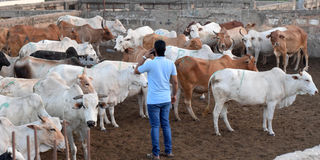Mombasa: The big city without a slaughterhouse

Mombasa County has not managed to set up a slaughterhouse leaving the lucrative business to its neighbouring counties of Kwale and Kilifi.
What you need to know:
- Goat meat and beef biryani is one of the unique foods popular in the Coastal city but surprisingly, many residents do not know the source of the tonnes of meat consumed in Mombasa.
- This is because Mombasa has no slaughterhouse despite the huge demand for meat in the region.
Mombasa is, without doubt, a foodies’ paradise, with an array of street food, traditional dishes, and fusion cuisine to choose from.
Goat meat and beef biryani is one of the unique foods popular in the Coastal city but surprisingly, many residents do not know the source of the tonnes of meat consumed in Mombasa.
This is because Mombasa has no slaughterhouse despite the huge demand for meat in the region.
For many years now, the town has been without a slaughterhouse, depending on abattoirs situated in Mariakani, Mazeras and Vipingo in Kwale and Kilifi counties for its supplies.
This situation makes it an agonising task for traders in the entire multimillion-shilling supply chain—from slaughtering the animals to transporting them to the numerous butcheries in the town and its vicinities.
It is no wonder that in Mombasa, one has to make bookings early at butcheries for niche products such as mutton, liver or tripe popularly known as ‘matumbo’ because supplies are always limited.

Kilifi's slaughter house that supplies Mombasa with meat.
Most of the youth here cannot remember ever seeing any slaughterhouse in the second largest city of Kenya with some locals recalling the only one that existed in the Makadara area in the 70s, vanished in the 80s after the land was allegedly grabbed.
“I remember when I was young we used to visit Makadara slaughterhouse in Mombasa which was owned by foreigners and local Arabs but since it was closed, we depend on meat supply from neighbouring counties,” said Hamisi Nzuka, one of the Mombasa residents.
More than 10 years after devolution, with agriculture and livestock management being delegated to devolved units, Mombasa County has not managed to set up a slaughterhouse leaving the lucrative business to its neighbouring counties of Kwale and Kilifi.
The lack of slaughterhouses has led to an increase in operating costs for meat traders in Mombasa as they are forced to incur more transportation costs considering Mariakani slaughterhouse is situated about 42 kilometers from Mombasa.
For the two neighbouring counties, the business has employed hundreds of people with the two abattoirs supplying more than 98 per cent of meat to Mombasa.
Uwanja wa Ndege slaughterhouse head of operations Mwinyi Hajji said the facility has limited space but the demand is huge as a result of increasing eateries and supermarkets.
“Our largest market is Mombasa where we supply meat to local butcheries and supermarkets. We are overwhelmed by demand as the population in Mombasa has been increasing with the slaughterhouse having a limited capacity,” said Mr Hajji.
Uwanja slaughterhouse meat Inspector Kalu Mwalaa said Kilifi County has been keen on maintaining meat standards to keep their clients in Mombasa.
“In the Coast region, the main problem is tsetse fly related diseases but the surveillance team is working to ensure no contaminated meat reaches the market. All animals are inspected before and after slaughtering,” said Mr Mwalaa.
Ahmed Samoh, one of the livestock traders in Mariakani said the facility receives more than 1,000 cows, goats and sheep from different areas to feed the Mariakani slaughterhouse but there is a need to revamp the abattoirs.
“We slaughter about 80-100 cows daily for the Mombasa market because of our facility but if we have a modern slaughterhouse, we will be able to supply the market with ease. Most of our animals are bought as far as North Eastern, Kibwezi, and Taita-Taveta ranches among others,” said Mr Samoh.
The traders said that they earn between Sh70,000 and Sh80,000 in revenue from slaughtering one cow.
This translates to over Sh7 million on a good day when they slaughter more than 100 cows.
Meat demand in Mombasa has forced some locals to create illegal slaughterhouses where locals slaughter animals, especially goats but without regular inspections or adherence to food safety. This has been going on in areas such as Majengo and Kikoani.
The National Government which runs the Kenya Meat Commission (KMC) factory in Kibarani through the Ministry of Defense has also taken advantage of the demand to increase its outlets in Mombasa.
KMC has since opened its outlets for its products in Makupa, Likoni, Changamwe and Nyali.
The Mombasa County government has acknowledged the need to have more slaughterhouses as the population increases.
The county’s Blue Economy & Livestock chief officer Hamid Shihan said Governor Abdulswamad Nassir’s regime has identified the gap in the supply chain and they intend to construct one during his tenure.
“There is a budgetary allocation for the construction of an abattoir in Bonje, a process that has been met with land wrangles that are threatening to stall the construction,” said the county officer.
Completion of the project would contribute to adding sources of revenue to the county besides creating job opportunities for the locals.





